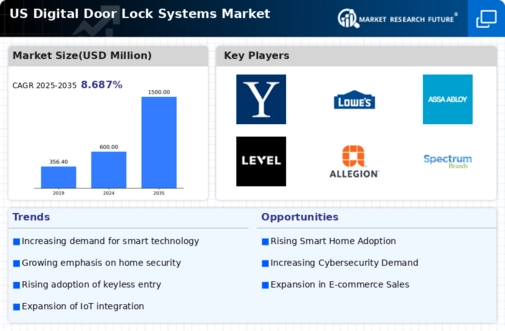Rising Security Concerns
The increasing prevalence of security threats in residential and commercial properties drives demand for advanced locking solutions. As crime rates fluctuate, consumers are more inclined to invest in digital door-lock-systems that offer enhanced security features. The digital door-lock-systems market is witnessing a surge in adoption as individuals seek to protect their homes and businesses. According to recent data, approximately 70% of homeowners express concerns about burglary, prompting them to consider smart locks as a viable solution. This heightened awareness of security risks is likely to propel the market forward, as consumers prioritize safety and convenience in their purchasing decisions.
Increased E-commerce Sales
The rise of e-commerce has transformed consumer purchasing behavior, impacting the digital door-lock-systems market. With more consumers shopping online, the need for secure delivery options has become paramount. Digital door-lock-systems that allow for secure package deliveries are gaining traction, as they provide a solution to the growing concern of package theft. Recent studies indicate that nearly 30% of consumers have experienced package theft, leading to a heightened interest in smart locks that facilitate secure deliveries. This trend is expected to drive growth in the digital door-lock-systems market, as consumers prioritize security in their online shopping experiences.
Technological Advancements
Rapid advancements in technology are significantly influencing the digital door-lock-systems market. Innovations such as biometric recognition, mobile app integration, and remote access capabilities are becoming increasingly prevalent. These features not only enhance user convenience but also improve security measures. The market is projected to grow at a CAGR of around 15% over the next five years, driven by these technological developments. As manufacturers continue to innovate and introduce new functionalities, consumers are likely to gravitate towards digital door-lock-systems that offer cutting-edge technology, thereby expanding the market further.
Growing Demand for Smart Homes
The trend towards smart home integration is a key driver for the digital door-lock-systems market. As more consumers adopt smart home technologies, the demand for compatible digital locks is on the rise. Approximately 40% of households in the US are expected to have smart home devices by 2026, creating a substantial market for digital door-lock-systems that can seamlessly integrate with other smart devices. This interconnectedness not only enhances user experience but also promotes energy efficiency and security. Consequently, the digital door-lock-systems market is likely to benefit from this growing trend, as consumers seek cohesive smart home solutions.
Regulatory Support for Smart Security Solutions
Regulatory frameworks promoting the adoption of smart security solutions are emerging as a significant driver for the digital door-lock-systems market. Government initiatives aimed at enhancing public safety and security are encouraging the use of advanced locking systems. For instance, various states are implementing building codes that require the installation of smart locks in new constructions. This regulatory support not only fosters consumer confidence but also stimulates market growth. As more regulations are introduced, the digital door-lock-systems market is likely to expand, as manufacturers align their products with these evolving standards.
























Leave a Comment